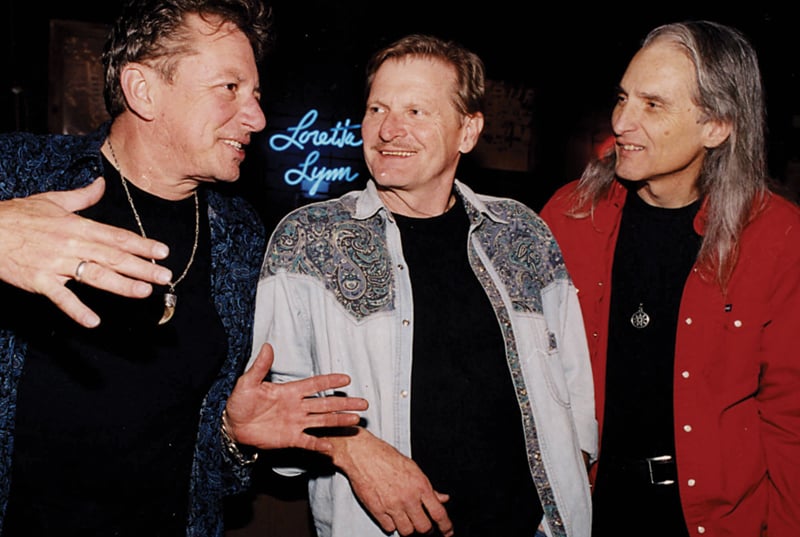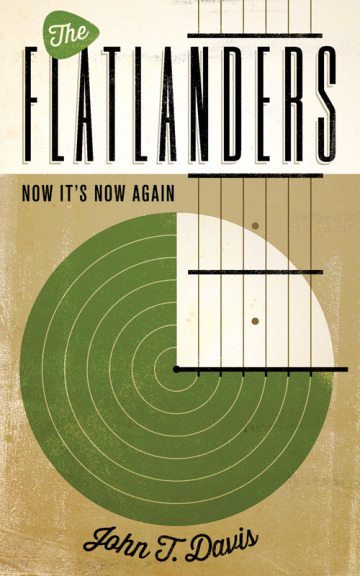
New Biography Compiles the Legends of The Flatlanders

A version of this story ran in the October 2014 issue.
Above: Left to Right: Joe Ely, Butch Hancock and Jimmie Dale Gilmore at Billy Bob’s Texas in Fort Worth, Feb. 27, 2004.
One of the famous old saws of rock-music criticism is that only a few thousand people ever bought the Velvet Underground’s first record, but every last one of those people subsequently went out and started a band of her own. Texas’ canonical corollary to the Velvet Underground (forebear to virulent strains of punk and art rock) is The Flatlanders (retrospective precursors to alternative country/Americana). Not only did almost nobody hear the Flatlanders’ first record—a record, let it be resonantly noted, that prominently featured an actual old saw—but it wasn’t even released until almost 20 years after it had been recorded. The few thousand people who heard it then were all music writers.

By John T. Davis
University of Texas Press
228 pages; $19.95
Which is a bit of a shame, of course, because the synchronistic triumvirate of Joe Ely, Jimmie Dale Gilmore and Butch Hancock (with assists from sawyer Steve Wesson, mandolinist Tony Pearson, bassist Sylvester Rice and guitarist/producer Lloyd Maines) is a singular musical entity. It’s also an acquired—if acclaimed—taste, and John T. Davis, one of the most well-seasoned of Texas-music scribes, doesn’t bother making too much of a case for the band’s undersung importance or neglected influence or ill-acknowledged greatness, or any such critical inflationism. Accordionist Ponty Bone, who later joined the Joe Ely band, once described the Flatlanders’ fledgling following as “small circles of good taste,” and that still seems plenty enough to satisfy everyone involved. This book isn’t an argument. It’s a chronicle of a circle.
And since the Flatlanders saga is such a full circle, with a recognizable beginning, middle, and for-all-intents-and-purposes end, it makes for a great story. It starts, more or less, with a series of low-rent late-’60s house parties on 14th Street in Lubbock and ends with a valedictory, though hardly final, 2012 performance in New York City’s Carnegie Hall.
How three kindred spirits got from there to here is a tale whose key words seem to be “accidental” and “naive.” As music writer Don McLeese once wrote in a 2002 issue of Americana magazine No Depression, and as requoted in Davis’ book, “A lot of bands pretend to be friends; these were friends who had once pretended to be a band.”
Ely’s, Hancock’s and Gilmore’s individual trajectories, influenced by Beat writers, Elvis and Eastern mysticism, merged in the weirdly creative crucible of Lubbock. In 1972, inspired by their own living-room hootenannies, they converged in Nashville to record an album. Nashville had no idea what to do with it (“the sort of hippie foolishness up with which 1972-era Nashville would not put,” in Davis’ memorable phrasing), and never released it.
So The Flatlanders—already more a happenstance congregation than a formal band—returned to Texas and reconvened in the more amenable environs of Austin, where Willie Nelson was busy making country music safe for hippies.
Ely, Hancock and Gilmore each pursued his own career in and out of Austin, but the three joined up on stages just often enough to keep the idea of a band, at least, alive. They opened and closed Austin’s iconic Armadillo World Headquarters in 1970 and 1980, respectively.
It was another 10 years before Rounder Records released 13 of the original 17 Nashville tracks under the title More A Legend Than A Band, introducing a small circle of the wider world to what The New York Times would call “a supergroup in reverse.” In another decade and change, New West Records released 2002’s Now Again, the group’s first new record in 30 years. A decade later, after the release of three more records of old, live and new material, the long-lost Odessa Tapes, recorded live in 1972, resurfaced. The Odessa Tapes were hailed as the band-not-band’s “holy grail,” and spawned the late-career/non-career tour that ended at Carnegie Hall.
If Davis’ account reads almost like a fairy tale, well, why not? It’s got all the classic elements: a fellowship; a mission (of sorts); a grail lost and found; a reunion. And as protagonists, The Flatlanders are a boy band straight out of Joseph Campbell. Joe the warrior. Butch the trickster. Jimmie Dale the seeker.
Theirs is a ripping yarn made all the rippinger by the almost uncanny quotability of seemingly everyone involved. Gilmore, just for instance: “Joe used to say that none of us had a thimbleful of ambition. But between the three of us, we had a towering lack of ambition.” Cameos by Townes Van Zandt, Terry Allen, Buddy Holly, Roy Orbison, David Byrne (who offers a version of the Velvet Underground comparison), the Clash, Mudhoney, Robert Redford, David Letterman, Don Imus, and BBQ entrepreneur C.B. Stubblefield spice the mix, even if a reader groans to see the phrase “musical gumbo” rolled yet again out of the rest home for retired music-journalism clichés.
And a reader may at times wish for a chronicler with a perhaps more simpatico sense of the metaphysical (longtime band compadre Michael Ventura, maybe?) or a more incisive critical faculty (fellow flatland traveler Dave Hickey, perhaps?). But then one tries to force a Jimmie Dale Gilmore lyric to stop squirming and mean something, dammit, and one is thankful anew for Davis’ earthier honky-tonk style.
On Hancock’s songwriting, for instance, Davis writes: “He can conjure up an image with a razor’s efficiency… Or he can indulge in a couplet corny enough to melt an iPod.”
But then any writer who tries to describe music is outgunned from the get-go, at the mercy of metaphors both inadequate and absurd and truths that become truisms as fast as they’re typed. Does anyone need to read Jimmie Dale Gilmore’s voice described as “high and lonesome” one more time, never mind twice? No. Is there a phrase that better describes Jimmie Dale Gilmore’s voice? No again.
Even so, Davis wisely spreads the wealth in telling the story of a band that may well be more widely written about than listened to. Quotes are drawn from Texas Monthly, Esquire, Rolling Stone, The New York Times, the Austin Chronicle, the Austin American-Statesman, Texas Music, No Depression, etc., etc.—Davis even quotes himself on Joe Ely at one point—making Now It’s Now Again feel a bit like a clip job, despite the almost 40 interviews Davis conducted for the book.
But in the end, as befits the best-of Flatlanders anthology that’s surely in the offing now that all the once-lost tapes have been found, and as with the individual Flatlanders themselves, it’s nice to have the stories all in one place.
To support journalism like this, donate to the Texas Observer.


